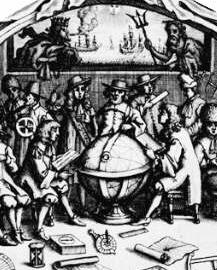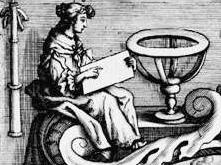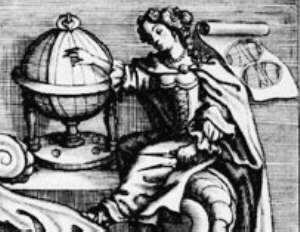 Department
of
Department
of
Science & Technology Studies
University College London
Nicholas Kollerstrom's
Newton's 1702 Lunar Theory
Finding the Longitude
At the dawn of the new century, there appeared the first
two textbooks of Newtonian astronomy: Gregory's Astronomiae Physicae
of 1702, and Whiston's Praelectiones Astronomicae of 1707. They
were meant to challenge the Cartesian philosophy then being taught in the
schools of England, and both contained the full
text of Isaac Newton's Theory of the Moon's Motion (hereinafter
referred to as 'TMM'). Though occupying a mere five pages of Gregory's
book, it formed an essential part of that challenge, for it purported to
show that the new Newtonian philosophy had a practical and not merely theoretical
significance.
Few were the sailors who made grey hairs, as the saying
went, in those days. As their ships sailed back, laden with chocolate from
South America or silks from India, they were as we still say today, quite
'at sea' once land disappeared. Huge prizes were offered for any means
to find longitude. 'Finding the longitude' entered the vernacular as meaning
something ultimately desirable, but which one despaired of achieving. And
yet, Britain's two most distinguished astronomers of the time - Captain
Edmond Halley and the Reverend John Flamsteed - had more or less diametrically
opposed opinions as to the real value of TMM. The former claimed that it
profoundly improved lunar prediction, while the latter averred that it
gave no real improvement upon existing tables.
At least one of these books definitely claimed that TMM
had achieved what was then regarded as well-nigh impossible: showing how
to predict the Moon's position in the sky well enough to be of service
for finding longitude. French astronomical treatises in the opening decades
of the eighteenth century struck a rather sceptical note over this claim,
while British ephemerides-composers tended to regard TMM as a kind of Holy
Grail: something which would render possible the production of what was
most desired, a reliable lunar ephemeris, if only it could be rightly interpreted.
Historians of science have been reluctant to comment upon
the matter. Bernard Cohen was not exaggerating when in 1975 he stated:
'...this work [TMM] has hardly
ever been discussed (or even referred to) in the literature concerning
Newton or the history of astronomy (Cohen, p.1)
 As
the literature there alludes to is of no small volume, such an omission
shows that this opus was not regarded as being significant. Yet, TMM was
frequently reprinted through the first half of the eighteenth century,
more often than any other single work of Newton's. Just about everything
except the authorship of TMM has been unsettled. Was TMM in fact used,
and if so, would its prescriptions have defined the much-sought lunar position,
to anything resembling the claim made by its publisher?
As
the literature there alludes to is of no small volume, such an omission
shows that this opus was not regarded as being significant. Yet, TMM was
frequently reprinted through the first half of the eighteenth century,
more often than any other single work of Newton's. Just about everything
except the authorship of TMM has been unsettled. Was TMM in fact used,
and if so, would its prescriptions have defined the much-sought lunar position,
to anything resembling the claim made by its publisher?
The onward-rolling tercentenary process has now passed
by the anniversary of the commencement at Greenwich in 1691 of the most
accurate series of positional astronomy readings ever made, has passed
by Flamsteed's marriage, Newton's nervous breakdown, and the historic commencement
of the collaboration between these two on the great endeavour in 1694-5,
not without strife, a linking together of theory and practice. Newton abandoned
the whole endeavour in late 1695, when he left the groves of academe for
London to become involved in the reminting of the nation's coinage at the
Royal Mint.
The fruits of his labour did not surface until the beginning
of the new century. Some have taken the view of Richard Westfall, that
TMM had been composed some years earlier and was merely given to Gregory
at this date (1980, p.547). My researches did not confirm this view, mainly
because of the anguished sense of failure which haunted Newton over this
endeavour, so well described in Whiteside's 1976 essay. As
this issue is rather crucial, let us quote Newton's words written to Flamsteed
in February 1694, optimistically expressing his intention:
'For I find this theory so
very intricate, and the theory of gravity so necessary to it, that I am
satisfied it will never be perfected but by somebody who understands the
theory of gravity as well, or better than I do.'
 These
words were to be vindicated by the mighty labours of Clairaut, Lagrange
and Laplace in the next century, using the Leibnizian calculus. But at
that time, Newton was confronted by abject failure: he later wrote wrathfully
to Flamsteed on hearing that the latter proposed to make public the fact
that he had supplied Newton with over a hundred and fifty lunar positions.
These
words were to be vindicated by the mighty labours of Clairaut, Lagrange
and Laplace in the next century, using the Leibnizian calculus. But at
that time, Newton was confronted by abject failure: he later wrote wrathfully
to Flamsteed on hearing that the latter proposed to make public the fact
that he had supplied Newton with over a hundred and fifty lunar positions.
'I was concerned to be publicly
brought upon the stage about what, perhaps, will never be fitted for the
public, and thereby the world put into an expectation of what, perhaps,
they are never like to have' (January 6, 1699)
That was his last known comment upon his endeavour
with the lunar theory prior to TMM's composition, which is curious. Flamsteed
had wanted to tell the world that, as the King's Observatory, he had spent
a year obtaining lunar data for Newton, by way of explaining what he was
up to. He received a stern Newtonian rebuke denying him this option.
That doesn't sound like deception, for which reason we
may accept David Gregory's view that TMM was only composed at the start
of the eighteenth-century. Historians may have been silent about it because
it contained no gravity theory. It has been little appreciated that Halley
spent eighteen years checking out how well Newton's TMM worked on a more
or less daily basis. One could say (as Whiteside did, in the 1975 essay)
that the six extra equations which Newton formulated were one of the first
attempt to grapple with the three-body problem, of dynamical interactions
between Earth,Moon and Sun.
Readers of Dava Sobell's historical novel may not fully
appreciate the extent to which the lunar method of finding terrestrial
longitude was successful. As a result of its success, the worldwide
adoption of GMT and of the zero of longitude through Greenwich took place.
The star-maps of Flamsteed's Historia Coelestis Brittanica of 1729
became more widely used than any others in the eighteenth century by European
sailors, as also contributed to the adoption of the Greenwich longitude.
To quote Derek Howse, 'The heyday of lunars was probably from about 1780
to 1840' (Nov. 1993, p.7). The lunar method was
generally preferred to use of chronometers because it was cheaper. Also,
it was required as a backup even if a ship had invested in a chronometer.
The lunar method was first used at sea with success in 1753 by Nicholas-Louis
de Lacaille while crossing the Atlantic crossing (Howse 1993 p.4).
Eight decades after Newton and Gregory visited Flamsteed
in the Autumn of 1694 at Greenwich, there inspecting tables of discrepancies
between theoretical and observed values of lunar longitude, which stimulated
the mathematician to begin that great endeavour, the problem was resolved.
The intractable three-body problem had been dealt with. Ultimately
this was a story of success, of successful endeavour, in the course of
which the stars received their numbers from the first Astronomer Royal,
time became measured from the setting of his clock, and longitude divisions
of the globe were marked from his workplace.
The contents of this page remain
the copyrighted, intellectual property of Nicholas Kollerstrom. Details.
rev: February 1998 

 As
the literature there alludes to is of no small volume, such an omission
shows that this opus was not regarded as being significant. Yet, TMM was
frequently reprinted through the first half of the eighteenth century,
more often than any other single work of Newton's. Just about everything
except the authorship of TMM has been unsettled. Was TMM in fact used,
and if so, would its prescriptions have defined the much-sought lunar position,
to anything resembling the claim made by its publisher?
As
the literature there alludes to is of no small volume, such an omission
shows that this opus was not regarded as being significant. Yet, TMM was
frequently reprinted through the first half of the eighteenth century,
more often than any other single work of Newton's. Just about everything
except the authorship of TMM has been unsettled. Was TMM in fact used,
and if so, would its prescriptions have defined the much-sought lunar position,
to anything resembling the claim made by its publisher?
 Department
of
Department
of
 These
words were to be vindicated by the mighty labours of Clairaut, Lagrange
and Laplace in the next century, using the Leibnizian calculus. But at
that time, Newton was confronted by abject failure: he later wrote wrathfully
to Flamsteed on hearing that the latter proposed to make public the fact
that he had supplied Newton with over a hundred and fifty lunar positions.
These
words were to be vindicated by the mighty labours of Clairaut, Lagrange
and Laplace in the next century, using the Leibnizian calculus. But at
that time, Newton was confronted by abject failure: he later wrote wrathfully
to Flamsteed on hearing that the latter proposed to make public the fact
that he had supplied Newton with over a hundred and fifty lunar positions.